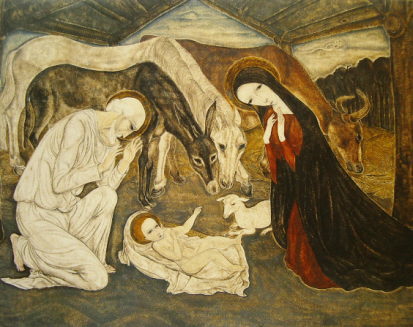THE MAGAZINE
by George Clifford
Few people today know that the Nazis tried to remove Christ from Christmas:
For the perfect Nazi Christmas, you had to hang glittering swastikas and toy grenades from the pine tree in the living room and, in your freshly pressed uniform, belt out carols urging German women to make babies for the Führer rather than worship the Jewish Baby Jesus. Then came the moment to light the pagan candleholders — hand-made by laborers at Dachau. (Roger Boyes, “How the Nazis tried to take Christ out of Christmas,” The Times, accessed November 17, 2009.)
More surprisingly, significant manifestations of the Nazi efforts to remove Christ from Christmas remained embedded in German culture throughout much of the latter half of the twentieth century. Germans continued to sing carols and hymns, revised by the Nazis to excise references to Jesus and the Christian story, often unaware of how the Nazis had altered the lyrics. For example, Unto Us a Time Has Come became a hymn of praise about snowy fields instead of lauding God’s gift of the Christ-child.
Unlike what happened in Germany with Hitler’s propagandists centrally directing the effort to transform Christmas from a celebration of Jesus’ birth into adulation of the Fuhrer and the Third Reich, today’s growing disconnection between Christ and Christmas is more insidious and operates without any central authority.
Unfortunately, two strawmen are often lightning rods for Christian efforts to keep Christ at the heart of Christmas. These strawmen are irrelevant distractions. First, the growing disconnect between Christ and Christmas has nothing to do with removing Christian symbols, including Christmas decorations and Nativity scenes, from public property. Using state resources to promote a particular religion in a secular, multi-cultural democracy inappropriately demeans non-Christians and their freedom to practice their own (or no) religion. In short, Christian displays on public property reflect a lack of love for our non-Christian neighbor. Christian displays belong on Christian owned or leased property.
Second, complaints about substituting the now seemingly ubiquitous Xmas for Christmas reflect an inappropriate desire to control the speech of others and a lack of understanding of Christian history. The Greek letter chi, written in Greek as X) was one of the first Christian symbols. Rightly interpreted, Xmas denotes Christ’s mass, a Eucharistic thanksgiving or season of commemoration for God’s gift of the Christ child, which is what the word Christmas itself means.
The real threat to keeping Christ in Christmas in twenty-first century developed countries is the commercialization of the holiday, transforming a spiritual event into a season generally filled with widely extravagant expectations of partying, decorations, and unaffordable gift giving. This is a battle that Christians fought once before and won. As John Buchanan, the editor of the Christian Century, has observed,
One of the most memorable sermons I ever heard – one of the very few I actually remember – was a Christmas Day sermon preached by Charles Leber. At the time, he and Ulysses Blake were co-pastors of First Presbyterian Church on Chicago’s South Side. Leber’s sermon was title ‘Another Roman Holiday.’ He explained that the early church chose December 25 to celebrate Jesus’ birth even though everyone knew the birth had happened sometime in the spring. December 25 was the beginning of the Romans’ year-end holiday, which Leber said was quite a bash: seven straight days of eating, drinking, and reveling. The Christians did not participate in these revels. They decided to draw attention to themselves by rejecting the celebration. And so, to provide an alternative and to help them resist the sensual temptations of the Roman holiday, they came up with Christmas. (“Song in the City,” Christian Century, 13 Dec 2005, 3)
Christians still comprise a sizable and influential percentage of the US population and a sufficiently substantial minority of ten percent or more to be able to exert considerable influence in most other developed nations. We need not lose the current battle to keep Christ in Christmas.
To keep Christ in Christmas, live into the story of Christmas, which is a synopsis of the gospel, by intentionally cultivating practices such as these:
- Becoming spiritual leaven instead of becoming co-opted by the holiday’s secular, commercial ethos
- Giving alternative gifts congruent with Jesus’ love, e.g., a gift of a goat to a hungry family in the name of the person to whom one wishes to give a gift
- Focusing, as did Jesus, on relationships and people instead of things and fleeting pleasures
- Developing counter-cultural Christmas observances that tell the story of the birth of the Christ child and that invite people to explore that story’s meaning in ways appropriate to a biblically illiterate society.
Whether we in the twenty-first century succeed in keeping Christ in Christmas may well hinge upon our answer to this poignant and memorable question that Marcus Borg and John Dominic Crossan have posed:
Christmas is not about tinsel and mistletoe or even ornaments and presents, but about what means will we use toward the end of a peace from heaven upon our earth. Or is “peace on earth” but a Christmas ornament taken each year from attic or basement and returned there as soon as possible? (The First Christmas (New York: HarperOne, 2007), p. 167)
George Clifford, a priest in the Diocese of Hawai’i, served as a Navy chaplain for twenty-four years, has taught ethics and the philosophy of religion, and now blogs at Ethical Musings.
image: Birth of Jesus Christ by Tsuguharu Foujita

